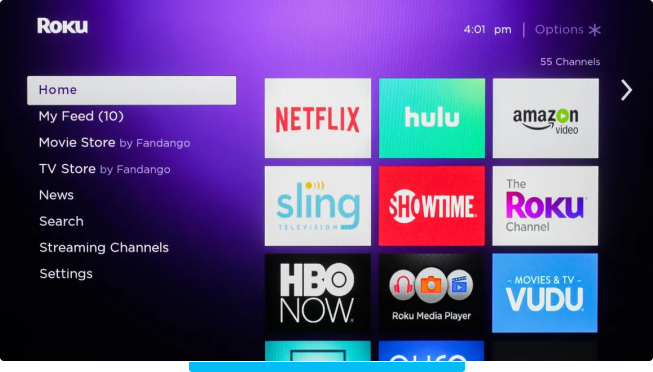
Over-the-top (OTT) services are online streaming services like Sling TV, Hulu, Philo, FuboTV, Disney+ and Pluto tv, which collectively are quickly becoming the primary way people watch movies and television these days. OTT advertising allows advertisers to reach their target audience members who have stopped using cable or satellite TV in order to save money, or are simply looking for a more flexible way to watch on-demand content on any device, including the big TV screen in their living rooms.
Connected TV (CTV) is the big screen device you are watching your OTT content on. This can be through a smart TV, gaming console, Amazon Fire Stick, Chromecast, or something else. CTV and OTT are often used interchangeably, but there is a distinct difference between the two terms. CTV does not refer to streaming shows through a phone or computer, only a TV itself and whatever device it is connected to; by contrast, OTT is the streaming service itself, which can be delivered through CTV, but it also is streamed on computers, tablets and phones.
This is a booming industry: While OTT CTV advertising is still fairly young, OTT ad spend is projected to see a 44 percent boost this year, reaching $5 billion (1).
How OTT Ads Work
OTT ads are inserted into ad breaks (aka ad pods) as the content plays via the TV streaming services. Just like regular linear TV, the ads cannot be skipped and they are formatted for a full screen, so they are 100% viewable at all times. From the viewer’s standpoint, these ads may seem no different from regular television ads (and, in fact, the ad creative itself is often identical) but the power is in the targeting capabilities operating behind the scenes. Any good OTT ad delivery platform can target viewers more directly and efficiently than traditional TV, so it’s no longer “one size fits all” advertising approach.
Advantages of OTT CTV Advertising
There are several benefits that you can enjoy when advertising on OTT/CTV.
Targeting
The most significant benefit is the control you have over your targeting. Unlike traditional television ads, where you run them on specific channels and hope your audience sees them, you can use household demographics, incomes, interests, purchasing behavior, etc. to target the right people with more precision. Moreover, any decent OTT advertising platform tracks performance metrics and provides insights to allow you to see how much engagement your ads are getting and from which audience segment, so you can make real-time ad campaign adjustments if needed. These insights are based on metrics like reach, frequency, and demographics of a given audience — age, gender, income, etc. — and their shopping behaviors and product interests. It’s all about giving the advertiser brand the right level of exposure to the right television viewers, creating and strengthening brand awareness in the process.
Retargeting
Part of what makes CTV ads so effective is that they are full screen on the TV, so they can have a stronger effect on those viewing them than they might have if the ad is on their phone or laptop. While your ad is typically not clickable in this format, if the audience is watching this on their TV, their phone is probably right next to them, so they can visit your site right away.
When someone watches one of your ads to completion, you can then retarget them with clickable ads on their other devices, helping to increase their interest in your brand or products and get you those conversions.
Interactive
While you cannot make OTT ads clickable, there are some options for interactive ads on some OTT services. Hulu, for example, will sometimes offer a person watching the channel to interact with an ad in some way in order to eliminate ads for the rest of the episode they are watching. Interacting with the ads can help make a more profound impact on the consumer and make them interested in looking into your brand.
Costs Less Than TV Ads
OTT ads are typically cheaper than TV ads, especially since the price of advertising has gone up in recent years as more people drop cable. This has made OTT ads a much more affordable option, and since you have more precise targeting capabilities, you are getting more out of your advertising budget.
Measuring Your Campaign’s Success
With OTT CTV advertising, there is a full suite of reporting metrics to measure an OTT ad campaign’s impacts. OTT ads are not click-based campaigns, so you have to use other types of metrics such as CVR (Completed View Rates), Reach and Frequency to measure their success. JamLoop can provide you with reports on how your OTT CTV ads are doing for every ad impression served as it occurs. This drives a real-time conversation and feedback loop with the advertiser or the agency that represents it, ensuring an optimal result over the campaign lifetime.
With detailed ad delivery data and metrics at our fingertips, it is now becoming possible to attribute the success of an OTT campaign to other online and offline consumer behaviors, such as website visits, in-store visits, lift in brand awareness, etc. The approaches here vary in methodology and efficacy, and it is a hot topic of discussion within the industry as brands try to fully understand the impact of their OTT ad spend far beyond what has traditionally been available in linear television advertising. We will explore this topic in future postings.
Conclusion
OTT CTV advertising offers some unique features that are not available in traditional local TV advertising, so if you plan to use OTT ads to reach local streaming TV audiences at scale and with pinpointed accuracy, this is a great option. JamLoop’s OTT DSP platform will connect you to over 250 OTT premium publishers, so you can manage all of your ads on a single platform with a real-time detailed view of the results, with confidence. Contact JamLoop today to get started!
References:
(1) Guzenko, Ivan. “$5 Billion by 2020: How OTT, CTV, and Video Formats Build the Future of Advertising.” MarTechSeries. 06 Mar. 2020. https://martechseries.com/mts-insights/guest-authors/5-billion-by-2020-how-ott-ctv-and-video-formats-build-the-future-of-advertising/
It is easy to get started
Send us an RFP, and your dedicated JamLoop account manager won’t skip a beat. We’ll get right back to you with a customized media plan.
"*" indicates required fields

This DSP Sees a Future with
local streaming advertisers
JamLoop Founder and CEO Leif Welch featured as best vendor for indie agencies and SMBs.




